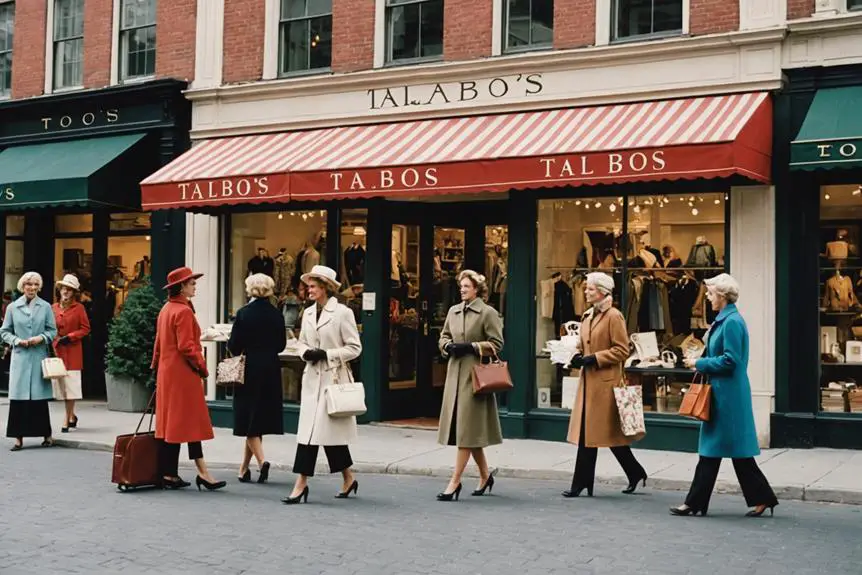Talbots, founded in 1947 by Nancy and Rudolf Talbot, has become a cornerstone of women's fashion, generating approximately $2 billion in revenue by 2021. The brand's history highlights a commitment to quality and customer loyalty, symbolized by its iconic red door, which represents hospitality. Over the decades, Talbots has experienced various ownership changes, transitioning from General Mills to Sycamore Partners in 2012, while maintaining a focus on timeless styles that cater to a diverse range of sizes. With a robust market presence and an unwavering dedication to enhancing the customer experience, Talbots continues to evolve with the shifting landscape of fashion trends. Explore the intricacies of this journey and its influence on modern retail.
Company Overview

Talbots embodies a rich legacy in women's fashion that reflects its commitment to quality and inclusivity. Founded in 1947 by Nancy and Rudolf Talbot in Hingham, Massachusetts, this specialty retailer has carved out a significant niche in the industry. With approximately 493 retail locations, including 425 core stores and 65 Factory Outlets, Talbots' retail operations contribute about 80% of its overall business. The brand's history showcases its evolution from a small catalog business to a nationwide presence, marked by its iconic red door symbolizing a welcoming shopping experience. In addition, the evolution of Talbots' logo reflects the brand's journey from traditional to modern aesthetics while aiding in identifying vintage clothing pieces.
In 2021, the company generated around $2 billion in revenue, underscoring its prominent position in the competitive landscape of women's fashion. Talbots is renowned for offering a diverse range of clothing, shoes, and accessories tailored to women of all sizes, from Misses to Plus Size, ensuring that everyone can find stylish options that fit well.
The brand underwent a significant shift in August 2012 when it moved from public to private ownership after being acquired by Sycamore Partners for $391 million, including debt. This acquisition marked a pivotal moment in Talbots' history, allowing it to refocus its efforts on delivering high-quality fashion while further expanding its reach in the market.
Brand Origins
Emerging from humble beginnings in 1947, the brand's origins are rooted in a vision for women's fashion that balanced elegance and accessibility. Founded by Nancy and Rudolf Talbot in Hingham, Massachusetts, Talbots quickly established itself as a New England lifestyle brand, specializing in women's apparel that resonated with a dedicated following.
The introduction of a clothing catalog in 1948 marked a significant turning point, allowing the brand to reach a wider audience and solidify its presence in the fashion market. The original red door of Talbots stores became synonymous with hospitality, symbolizing the brand's commitment to exceptional customer service.
Talbots emphasized a unique blend of timely and timeless styles, appealing to women who value classic, well-put-together appearances. This approach not only catered to current fashion needs but also fostered brand loyalty among customers.
Key aspects of Talbots' origins include:
- The founding vision of Nancy and Rudolf Talbot
- The pivotal role of the clothing catalog
- The iconic representation of the original red door
- A focus on timeless styles that resonate with women today
These elements combined to create a lasting legacy in women's fashion, making Talbots a beloved brand.
Historical Timeline

Building on its strong foundation, the timeline of Talbots reflects significant milestones that shaped its evolution as a prominent women's fashion retailer. Founded in 1947 by Nancy and Rudolf Talbot in Hingham, Massachusetts, the company quickly made its mark by launching a direct mail business in 1948, distributing 3,000 fliers that marked the beginning of its clothing catalog operations. This innovative approach set the stage for its future success.
In 1973, Talbots was sold to General Mills, which enabled its expansion along the U.S. East Coast, further solidifying its presence in the market. The acquisition by JUSCO Co. Ltd. in 1988 paved the way for Talbots to become a public company in 1993, trading under the ticker symbol TLB. This period of public ownership attracted investor interest and broadened its reach.
However, in 2012, a significant change occurred when Sycamore Partners acquired Talbots for $391 million, reverting it back to private ownership. This acquisition marked a new chapter, focusing on revitalizing the brand and expanding its market presence, showcasing Talbots' resilience and adaptability in the ever-evolving fashion landscape.
Leadership and Ownership
Leadership at Talbots has evolved considerably, reflecting a commitment to not only the brand's heritage but also to its future in women's fashion. Under the guidance of CEO Lizanne Kindler, the brand has undergone a revitalization, enhancing both its market presence and customer experience.
In August 2012, Talbots shifted from public to private ownership after Sycamore Partners acquired the company for $391 million, including debt. This strategic move allowed for a focused approach to elevating brand value and aligning the leadership structure with the needs of contemporary women.
Key elements of Talbots' leadership and ownership dynamics include:
- A strong commitment to women's fashion and needs
- A women-led leadership structure that resonates with the brand's core audience
- Sycamore Partners' emphasis on quality and brand enhancement
- A focus on improving the overall customer experience
Through these efforts, Talbots has redefined its identity, ensuring it remains relevant while honoring its legacy. The combination of strategic leadership and private ownership allows for agile decision-making, vital in today's competitive retail landscape.
Market Position

Talbots' market position is firmly established as a specialty retailer dedicated to women's fashion, offering timeless styles and quality clothing that resonates with a diverse clientele. Competing in a niche market, Talbots caters to various sizes, including Misses, Petite, Plus Size, and Plus Size Petite, ensuring that every woman finds something that suits her. With approximately 493 retail locations across the U.S., Talbots maintains a significant presence, with 80% of its overall business stemming from brick-and-mortar operations.
The brand has developed strong brand loyalty through an unwavering commitment to customer experience, making sure that each shopping experience is memorable and satisfying. Talbots emphasizes quality clothing, positioning itself as a trusted name in women's fashion. In addition to physical stores, the company employs an effective omni-channel approach, integrating catalog sales and online shopping, which contributes to 20% of its overall revenue. This strategy not only enhances customer engagement but also solidifies Talbots' status in the competitive landscape of women's clothing. By blending traditional retail with modern digital solutions, Talbots continues to fortify its market position as a leader in the specialty retail sector.
Growth and Expansion
As Talbots solidified its market position in women's fashion, it also focused on growth and expansion to reach a broader audience. This strategic move paved the way for impressive developments in the company's operations and offerings. By 1980, Talbots expanded its headquarters from 80,000 to 200,000 square feet, accommodating a growing workforce and operational demands.
By 1988, Talbots had achieved a notable presence in 25 states, generating annual sales of $350 million. To diversify its appeal, the company introduced several new product lines, including:
- Petite sizes in 1984
- Talbots Kids catalog in 1989
- Continued expansion into the Canadian market with Talbots Canada, Inc. in 1991
- Acquisition of J. Jill in 2006 for $517 million
These initiatives not only broadened Talbots' customer base but also reinforced its commitment to meeting diverse fashion needs. With the establishment of stores in Toronto, Talbots marked its entry into the Canadian market, further solidifying its brand presence. Each step in this growth journey reflects Talbots' strategic vision to remain relevant and competitive in the ever-evolving women's apparel landscape.
Financial Performance

Throughout the 1990s and into the early 2000s, Talbots navigated a dynamic financial landscape that reflected both challenges and resilience. After going public in November 1993, the company raised $242 million, and sales reached $737 million by year-end, marking a 15% increase from the previous year. However, in 1994, Talbots reported earnings of $63.6 million, a significant drop that underscored the volatility of the market. Despite this setback, the brand showcased remarkable recovery, achieving sales surpassing $1 billion in 1997, even amidst a two-year slump.
The turnaround began in late 1998, driven by a new merchandising team that revitalized the brand's offerings. By the third quarter of that year, Talbots exceeded earnings expectations, signaling a solid recovery. This positive momentum carried into the following years, with sales reaching an impressive $2.23 billion by 2007. This growth not only emphasized Talbots' resilience in the competitive women's apparel market but also highlighted its ability to adapt and thrive in a fluctuating economic environment. Overall, Talbots' financial performance during this period illustrates a brand committed to recovery and sustained growth.
Customer Engagement
Building on its financial recovery, Talbots has strategically focused on customer engagement to foster loyalty and enhance the overall shopping experience. By offering a multi-channel shopping approach, you can choose from physical stores, e-commerce, or catalog options, providing the flexibility you need. This commitment to diverse shopping methods not only boosts customer satisfaction but also strengthens community connection.
To further enrich customer loyalty, Talbots employs several key strategies:
- Exclusive promotions and seasonal sales via email subscriptions
- A Talbots Credit Card that offers additional shopping benefits
- Invitations to special events that create a sense of belonging
- Thorough customer support, including detailed FAQs and dedicated services
These elements work in harmony to create an engaging atmosphere where you feel valued and connected. Talbots recognizes that customer engagement goes beyond transactions; it's about building relationships. By prioritizing customer satisfaction and loyalty, the brand guarantees you have a personalized shopping experience that resonates with your needs and preferences. As you navigate through their offerings, you'll find that Talbots is committed to creating not just customers but a community of loyal advocates.
Frequently Asked Questions
What Is the History of Talbot Company?
You'll find Talbots' journey fascinating, starting as a small women's fashion chain in 1947. Its direct mail strategy in 1948 propelled growth, leading to nationwide expansion, public offerings, and significant brand recognition in the retail market.
What Age Group Wears Talbots?
You'll find that Talbots primarily appeals to women aged 35 and older. This demographic appreciates the brand's classic styles, quality clothing, and exceptional customer service, making it a go-to choice for sophisticated wardrobe needs.
Is Talbots Considered a High-End Store?
You might consider Talbots a high-end store due to its emphasis on quality, classic styles, and inclusive sizing. However, its pricing positions it more as a bridge between mid-range and high-end fashion.
What Is the History of the Talbot Family?
The Talbot family's journey began in 1947, founding a women's clothing store. Their commitment to quality and customer service shaped a unique brand identity, which still resonates today, reflecting their vision and influence in retail.




